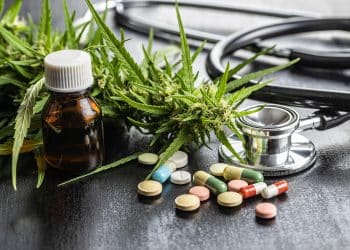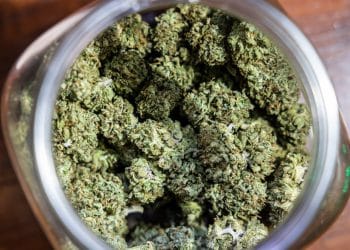Pain relief is a challenge that medical practitioners have been trying to overcome for centuries. Whether the pain is acute from a specific injury or surgery, or chronic and persistent, opioids have proven to be the most effective category in combating pain. While originally plant based, opioids have been a part of pain management for millennia, and their ubiquity is only growing. As of 2022, the opioid market is growing at a rate of 3.3% per year worldwide, and this figure does not include statistics from the illicit market which likely accounts for 10s if not 100s of billions of dollars.[1] While this may be good news for people managing their pain, there is some cause for alarm.
Opioids are such effective analgesics that their addiction potential is also staggeringly high. Studies vary, but most experts predict that between 10-25% of people who try opioids once may develop long term addictions. [2] As more of these drugs are taken, the more possibility exists for a high number of dangerous and potentially deadly side effects to manifest. Scientific research is ongoing to address both the addiction potential and how to improve the benefits, but it is worth looking at how the current market stands regarding synthetic opioids, their history, and the risks they pose to consumers.
History and Development of Synthetic Opioids
The use of poppies for pain relief goes back more than 8,000 years to the Sumerian empire. [3] While the Sumerians initially used resin from the plant to treat open wounds, cough, and diarrhea, they eventually synthesized the botanical material into opium in 3400 BC. Opium was the first opioid derivative, and it reigned as the pain relieving king across the world until the synthesis of morphine in 1805.[4]
Morphine was developed by a German chemist named Friedrich Sertürner. By isolating and concentrating the primary pain relieving compound from opium, Sertürner believed the streamlined drug would provide more pain relief while limiting opium’s addictive properties. This belief expanded morphine’s usage in hospitals and clinics across the world, and it was especially common during the American Civil War. [5] The resulting overreliance by medical professionals led to both mass addiction to morphine by the population, and an increased desire to continue researching opioids by pharmaceutical companies.
To feed both of these desires, heroin was first synthesized in 1874 by German chemist and Bayer employee Felix Hoffmann. [6] Bayer initially marketed heroin as both a pain reliever and as a treatment for tuberculosis, however it was also seen as a replacement option for morphine addicts. The theory that Bayer purported was that their new product could supplant previous opioid use through smaller doses. This was the same logic that morphine manufacturers used when comparing it to opium. This pattern has become all too common in the opioid market.
New products come with a promise of both higher strength, thus increasing the therapeutic benefits, and limited potential for abuse due to smaller doses. In the case with heroin, this proved to be another incorrect assumption. Heroin’s harmful and addictive nature did not give drug manufacturers pause. In the quest for increased potency, chemists continued their experiments into stronger opioids.
This came in the form of semisynthetic opioids in the 1910s, which included the synthesis of oxymorphone in 1914, oxycodone in 1916, and hydrocodone in 1920. [7] This push into semisynthetic opioids was motivated by several reasons. A big motivating factor came with the international recognition of The Hague Opium Convention of 1912 and the Geneva Convention of 1925. [8][9] These two international conventions officially recognized the addictive properties of opioids, and began setting up implements to control their usage and availability. This also included limiting the botanical material coming from poppies, which meant that drug manufacturers had to find another solution if they wanted to keep profiting off these powerful painkillers.
Synthetic opioids went a step beyond semi-synthetics, and became a loophole to get around these international restrictions. [10] Not only could companies justify a growing research and development budget, but they could also separate themselves entirely from the need to cultivate poppy plants as a part of their supply chain. As a result, methadone was developed in 1946, and fentanyl was first synthesized in 1959.
Fentanyl is currently the most concentrated opioid available, with an estimated strength ranging from 50-100 times greater than morphine and 25 times stronger than heroin. This level of pain relief was marketed to only the most severe patients, typically those facing late stage cancer or seeking comfort on their deathbeds. But as was apparent with both morphine and heroin before, fentanyl’s high potency provides therapeutic benefits while simultaneously spiking addiction rates. Fentanyl’s demand thanks to demand from the illicit recreational market, which has opened a Pandora’s Box that cannot be closed.
Physical Side Effects of Opioids
The physiological response of natural and synthetic opioids is basically the same. The big difference is how powerful the drugs, and thus the effect, are for the user. Taking any kind of opioid produces a response in the brain stem, which connects the brain to the nervous system. [11] The nervous system sends all kinds of immediate response both too and from the brain, the most significant for opioids being anything that has to do with physical sensations like pain.
As a result, with opioids blocking the signals from the body to the brain, users’ feelings of pain decrease significantly. This numbing or analgesic process also produces secondary side effects as well. Without pain, users are left with positive physiological responses like euphoria, relaxation, and sedation. [12]
For someone who needs to overcome debilitating pain, this is a good thing that can help the healing process. The problem is that opioids are so effective at limiting pain and producing euphoria that it can lead to long term addiction. [13] For some, opioid use began with the goal of blocking their pain, but it proved too difficult to wean themselves off when it came time to stop. This is made all the more difficult by the strong physical withdrawal symptoms that come from cessation of opioid use. [14] By comparison, these physiological responses are considered more beneficial.
When it comes to the negative opioid side effects, users may experience:
- vomiting,
- dizziness,
- respiratory depression.
The last one, respiratory depression, is typically what causes death or long term brain damage from opioid overdoses. [15] Considering the fact that opioids block signals from the nervous system to the brain via the brain stem, it makes sense that the same hindrance also works the other way too. What this means is that opioids can also block the signals coming from the brain to the body, most dangerously when it applies to involuntary actions like breathing or maintaining heart rate.
During an opioid overdose, the drug blocks the reminder from the brain for the body to keep breathing, which can lead to hypoxia and eventually to brain death. Beyond this, there are also situational risks associated with opioid use. Since vomiting is a common symptom, it is possible for users to choke if they do so while unconscious. This can also cause death, but it is due to an impeded airway that also causes suffocation.
This is a symptom that is not exclusive to opioids, but considering their overwhelming sedative effect, it is something that users should be cautious of. Additionally, ingestion methods play a role in establishing risks as well. Many users choose to inject opioids directly, and sharing needles has a 0.6% chance of contracting HIV.[16] This may not seem high, but if opioid users repeatedly use the same needles or are constantly sharing needles with risky compatriots, the odds increase rapidly.
Increased Dangers of Synthetic Opioids
The list of negative side effects seems to outweigh the positive ones, but that is not enough to slow down opioid use. Now that opioids are completely untethered from their poppy source, synthetic opioids pose an ever-growing risk to consumers for several reasons. For starters, as previously mentioned, fentanyl is significantly more potent than its predecessors. Not only does this mean a more powerful experience, but it also means an increased likelihood of respiratory depression. [17]
Fentanyl is worse than heroin and morphine when it comes to respiratory depression, affecting both the number of breaths and the amount of air per breath. Of course, these physiological responses are concerning, but the fact that these drugs are synthetic opens a new category of risk as well. These risks stem from the fact that synthetic opioids are produced in a laboratory environment. [18]
On its surface, this is not an inherently negative fact. Laboratory produced opioids have a consistency that is not always found with natural opioids. This laboratory production only becomes a concern when the supply chain has not been approved and regulated to ensure safety. This lack of oversight can translate to a higher risk of contaminated opioids. [19] It is impossible to list all the ways this is possible, but it could include unsafe laboratory environments, improperly maintained equipment, mismanaged ingredients or supply lines, or the combination of synthetic opioids with other drugs.
This lack of regulation also means that new forms of the same drug become available in slightly different forms. Fentanyl’s demand has lead to the synthesis of a whole family of similar drugs that includes acetyl fentanyl, furanyl fentanyl, butyryl fentanyl, and beta-hydroxythiofentanyl. [20] As the names imply, each one of these is similar to fentanyl. The problem is that small differences may lead to big differences in physiological responses. Each new synthesis has the potential for negative side effects and risks that have not been researched in any meaningful way. This is the second major risk associated with synthetic opioids.
When a user decides to source their opioids outside the legal channels, it is difficult to know what exactly they are getting. This goes beyond chemical composition as well. Seizures of fentanyl have included pills, powders, liquid solutions, and even disguised as candy, but this is only the beginning. [21] Fentanyl is increasingly being found in other drugs outside the opioid family, as its increased potency can increase euphoria for other categories as well. [22] This is not to say that this never happened before fentanyl, but considering the risks associated with synthetic opioids, unsuspecting doses only magnify the risks.
Strategies for Avoiding Risks
The first and most obvious solution is to consult with a medical professional when getting involved with opioids. This is true for every stage of the process. People facing chronic or acute pain should follow doctors’ prescriptions, those who feel their usage is getting out of control should seek help to manage the problem, and long term addicts should consult medical help to avoid the risks associated with overdoses or withdrawals.
If users do source their opioids outside regulated channels, it is possible to minimize the risk of their usage as well. For starters, a “drug checking” strategy is emerging as a means of preventing overdoses. [23] Depending on the location, government and nongovernmental organizations are offering lab testing for all kinds drugs, even outside opioids, to ensure the user knows the dosage and purity of the substance they are taking.
Additionally, there are needle exchange programs designed to limit the spread of HIV from sharing needles, with some areas going so far as establishing safe rooms for users to consume opioids in the presence of medical professionals. [24] Some communities choose not to take such a dramatic step, opting for a strategy that doesn’t imply a tolerance for drug use, but they still chose to provide naloxone for free to stop overdoses. [25]
At a minimum, opioid users should consider the size of their dosage and the company they are with when they ingest their substance. Limiting opioid risks may be as simple as having someone ready to jump into action if the worst happens.
References:
- AFFAIRS., UNITED NATIONS OFFICE ON DRUGS AND CRIME & DIVISION FOR TREATY. World Drug Report 2022. UNITED NATIONS, 2022.
- Fishbain, David A., et al. “What percentage of chronic nonmalignant pain patients exposed to chronic opioid analgesic therapy develop abuse/addiction and/or aberrant drug-related behaviors? A structured evidence-based review.” Pain medicine 9.4 (2008): 444-459.
- Boysen PG, Patel JH, King AN. Brief History of Opioids in Perioperative and Periprocedural Medicine to Inform the Future. Ochsner J. 2023 Spring;23(1):43-49. doi: 10.31486/toj.22.0065. PMID: 36936479; PMCID: PMC10016219.
- Gates, Marshall, and Gilg Tschudi. “The synthesis of morphine.” Journal of the American Chemical Society 78.7 (1956): 1380-1393.
- Paciorek, Jessica, and John Karras. “Medicine and Its Practice during the American Civil War.” TCNJ Journal of Student Scholarship 9 (2007): 1-12.
- Brodsky, Marc D. “History of heroin prevalence estimation techniques.” Self-report methods of estimating drug use: meeting current challenges to validity. National Institute on Drug Abuse Research Monograph. Vol. 57. 1985.
- Yarnell, Eric. “The botanical roots of pharmaceutical discovery.” Alternative and Complementary Therapies 6.3 (2000): 125-128.
- Collins, William J. “The international control of drugs of addiction: The present position of the international opium convention, 1912.” British Medical Journal 2.3064 (1919): 369.
- Bayer, Istvan, and Hamid Ghodse. “Evolution of international drug control, 1945–1995.” Bulletin on Narcotics 51.1 (1999): 1-17.
- Boysen, Philip G., Jenilkumar H. Patel, and Angelle N. King. “Brief history of opioids in perioperative and periprocedural medicine to inform the future.” Ochsner Journal 23.1 (2023): 43-49.
- Bershad, Anya K., et al. “Effects of opioid-and non-opioid analgesics on responses to psychosocial stress in humans.” Hormones and Behavior 102 (2018): 41-47.
- Benyamin, Ramsin, et al. “Opioid complications and side effects.” Pain physician 11.2S (2008): S105.
- Vowles, Kevin E., et al. “Rates of opioid misuse, abuse, and addiction in chronic pain: a systematic review and data synthesis.” Pain 156.4 (2015): 569-576.
- Kosten, Thomas R., and Louis E. Baxter. “Effective management of opioid withdrawal symptoms: A gateway to opioid dependence treatment.” The American journal on addictions 28.2 (2019): 55-62.
- Ramirez, Jan-Marino, et al. “Neuronal mechanisms underlying opioid-induced respiratory depression: our current understanding.” Journal of Neurophysiology 125.5 (2021): 1899-1919.
- Ball, Laura J., et al. “Sharing of injection drug preparation equipment is associated with HIV infection: a cross-sectional study.” JAIDS Journal of Acquired Immune Deficiency Syndromes 81.4 (2019): e99-e103.
- Lichtor, J. Lance, et al. “The relative potency of oral transmucosal fentanyl citrate compared with intravenous morphine in the treatment of moderate to severe postoperative pain.” Anesthesia & Analgesia 89.3 (1999): 732.
- Collins, Lacee K., et al. “Trends in the medical supply of fentanyl and fentanyl analogues: United States, 2006 to 2017.” Preventive medicine 123 (2019): 95-100.
- Carroll, Jennifer J., et al. “Exposure to fentanyl-contaminated heroin and overdose risk among illicit opioid users in Rhode Island: A mixed methods study.” International Journal of Drug Policy 46 (2017): 136-145.
- Website, N. (2022, March 3). About tramadol. nhs.uk. https://www.nhs.uk/medicines/tramadol/about-tramadol/
- Palamar, Joseph J., et al. “Trends in seizures of powders and pills containing illicit fentanyl in the United States, 2018 through 2021.” Drug and alcohol dependence 234 (2022): 109398.
- Kuczyńska, Katarzyna, et al. “Abuse of fentanyl: An emerging problem to face.” Forensic science international 289 (2018): 207-214.
- Laing, Matthew K., Kenneth W. Tupper, and Nadia Fairbairn. “Drug checking as a potential strategic overdose response in the fentanyl era.” International Journal of Drug Policy 62 (2018): 59-66.
- Vlahov, David, and Benjamin Junge. “The role of needle exchange programs in HIV prevention.” Public health reports 113.Suppl 1 (1998): 75.
- Clark, Angela K., Christine M. Wilder, and Erin L. Winstanley. “A systematic review of community opioid overdose prevention and naloxone distribution programs.” Journal of addiction medicine 8.3 (2014): 153-163.












